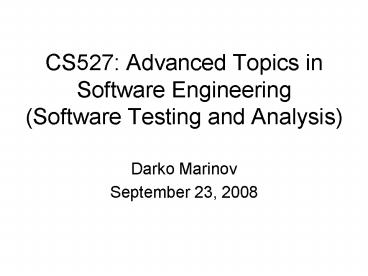CS527: Advanced Topics in Software Engineering (Software Testing and Analysis) - PowerPoint PPT Presentation
Title:
CS527: Advanced Topics in Software Engineering (Software Testing and Analysis)
Description:
Is it useful to get numerous test case runs that reveal the same bug? ... What types of attribute to use in cluster analysis for software testing? ... – PowerPoint PPT presentation
Number of Views:75
Avg rating:3.0/5.0
Title: CS527: Advanced Topics in Software Engineering (Software Testing and Analysis)
1
CS527 Advanced Topics in Software
Engineering(Software Testing and Analysis)
- Darko Marinov
- September 23, 2008
2
Schedule
- TODAY Sep 23 Test clustering
- Sep 25 Test granularity
- Your initial project idea due
- Sep 30 More on testing? Preferred topic?
- Oct 2 discussion of project ideas (no lecture)
- Your project proposals due
- Oct 7 on your presentations of papers related to
your projects - Any volunteers to present?
3
Class Info
- Reports You should have got comments
- Most of them are quite good
- If nothing pointed out, everything is fine
- Project ideas Please email them so far
- Automated GUI testing
- Checkpointing
- Improved testing of refactoring engines
- Testing databases
- Testing Photran refactoring engine
4
Paper Today
- Finding Failures by Cluster Analysis of Execution
Profiles by William Dickinson, David Leon, Andy
Podgurski (ICSE 2001)
5
Brief Summary
- Motivation manual inspection of test runs
(without exact oracles) is expensive - Problem filter runs to inspect
- Solution use clustering analysis
- Evaluation three series of experiments
- Results clustering helps
6
Some Terminology
- Observation-based testing
- Test test case, test input, test data
- Which one does this paper consider?
- Failure, fault, error
- Which one does this paper consider?
- Execution profiles
- Filtering procedure (based on clustering)
7
Clustering Use in One Slide
- Cluster analysis
- Split objects into groups based on
(dis)similarity - Dissimilarity metric Euclidean distance
- Approaches partitioning vs. hierarchical
(addlomerative vs. divisive) - Cluster filtering
- Key if failures are infrequent and have unusual
profiles, then failures are in small clusters - Clustering technique, of clusters, sampling
8
Clustering Technique
- Agglomerative hierarchical clustering
- Execution profiles
- Function caller/calllee (for each pair f and g)
- Simple function call (for each function f)
- Dissimilarity metrics based on n-dimensional
Eucledian distance - Transformations Binary, proportional, standard
deviation, histogram, linear regression - Hybrid count-binary, proportional-binary
9
Number and Sampling
- Number of clusters
- Fraction of test runs, from 1 to 30
- Sampling strategy
- Simple random sampling (of all runs)
- Doesnt require clustering
- N-per-cluster sampling (special case N1)
- More executions come from smaller clusters
- Adaptive sampling
- If a failure found in a cluster, select all runs
from it - Small clusters all runs from small clusters
10
Experimental Questions
- Q1 Is a significant number of failures often in
small clusters? - Q2 How likely is a sampling strategy to find at
least one failure, if any present? - Q3 How many failures do sampling strategies
find? - Q4 Which dissimilarity metrics and cluster
counters can find most failures?
11
Answers
- Q1 Is a significant number of failures often in
small clusters? - Yes, more than 50 in 50 of runs
- Q2 How likely is a sampling strategy to find at
least one failure, if any present? - Table 2 more clusters, more likely
- Q3 How many failures do sampling strategies
find? - failures found/ runs sampled gt 1
- Q4 Which dissimilarity metrics and cluster
counters can find most failures? - Metrics that focus on rare events
12
Questions for Discussion (1)
- How do clustering and prioritization relate?
- What new clustering or sampling techniques would
you propose? DH - How the operational profile can be used for
characterizing patterns of operational usage and
generating inputs? ST - Why in GCC simple random selection performs
better than 1-per-cluster? ST - Why choose those subject programs? PP
13
Questions for Discussion (2)
- Can we use execution profiles of the Eclipse's
refactoring engine with ASTGen? YL - Can we find hidden bugs using filtered execution
information? KB - Is it useful to get numerous test case runs that
reveal the same bug? - Does this favor finding more (rare) bugs over
finding important (frequent) bugs? - What is hot topic in testing test selection,
test minimization, test prioritization, test
clustering, automatic test generation...?
14
Questions for Discussion (3)
- What other clustering/prioritization techniques
exist? - What types of attribute to use in cluster
analysis for software testing? - Would another clustering algorithm but
agglomerative hierarchical be better? - How to fit clustering/prioritization in TDD?
- Is extra effectiveness of clustering and
prioritization techniques worth the extra cost
(compared to random)?































